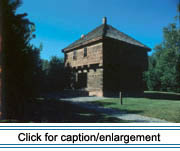|
 The
Fort Kent blockhouse is located at the confluence of the Fish River and
the St. John River in Fort Kent, Maine. This state-owned structure is
the only extant fortification relating to the "Bloodless" Aroostook War
of 1838ñ39, and the border dispute between Great Britain and the United
States. The signing of the Webster-Ashburton Treaty in 1842 settled the
boundary dispute between Maine and New Brunswick and reduced the need
for a fort, although federal troops remained there until 1845 to protect
Maineís and the United Statesí interests in the region. In addition to
being listed in the National Register of Historic Places, the structure
is a National Historic Landmark. The
Fort Kent blockhouse is located at the confluence of the Fish River and
the St. John River in Fort Kent, Maine. This state-owned structure is
the only extant fortification relating to the "Bloodless" Aroostook War
of 1838ñ39, and the border dispute between Great Britain and the United
States. The signing of the Webster-Ashburton Treaty in 1842 settled the
boundary dispute between Maine and New Brunswick and reduced the need
for a fort, although federal troops remained there until 1845 to protect
Maineís and the United Statesí interests in the region. In addition to
being listed in the National Register of Historic Places, the structure
is a National Historic Landmark.
 The
blockhouse is a two-story structure. Its walls are built of square-hewn
cedar logs, some of which measure over 19 inches in width. Although a
few minor changes have been made to the structure, including some related
to its present use as a museum, it remains a good example of early-19th-century
military architecture. Care and public presentation of this site is currently
provided by local Eagle Scouts, in cooperation with the Bureau of Parks
and Recreation, Maine Department of Conservation. The
blockhouse is a two-story structure. Its walls are built of square-hewn
cedar logs, some of which measure over 19 inches in width. Although a
few minor changes have been made to the structure, including some related
to its present use as a museum, it remains a good example of early-19th-century
military architecture. Care and public presentation of this site is currently
provided by local Eagle Scouts, in cooperation with the Bureau of Parks
and Recreation, Maine Department of Conservation.
|
 |

